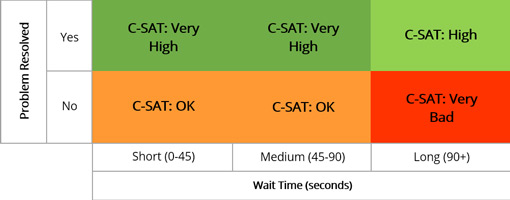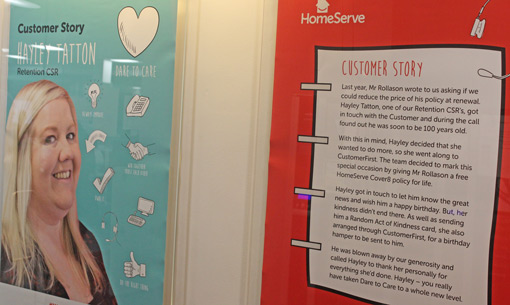Dave Salisbury defines the term “going the extra mile” in the contact centre and says what needs to happen for advisors to start doing so.
I recently met a unique call centre representative, who, when asked by management to “go the extra mile for the customer”, remarked, “I go the extra mile for the customer by simply answering the phone.”
Recently, “going the extra mile” has resurfaced as a customer service topic, and I think we need some parameters for understanding the term to really appreciate what it means to “go the extra mile”.
A Simple Definition
The saying “go the extra mile” originally comes from the Bible: “If anyone forces you to go one mile, go with him two miles.” [From The Sermon on the Mount – Matthew 5.41 ESV – Editor], coined in a tale where someone was asked to walk a mile with another person but chose to walk two.
This story demonstrates how going the extra mile is about going beyond what is expected and helping another in a thoughtful way, which would benefit them more than if the “helper” followed “procedure”.
So, in the contact centre, an advisor would “go the extra mile” if they went beyond standard company protocol in the best interest of the customer.
In the contact centre, an advisor would “go the extra mile” if they went beyond standard company protocol in the best interest of the customer.
However, it is sometimes contact centre protocol that prevents advisors from doing so, as highlighted below.
What’s Stopping Advisors From Going the Extra Mile?
Efficiency-Based Metrics
Think about this for a moment. In a metrics-measured call centre, does the representative have the time to engage the customer in idle chit-chat and remain productive per the metrics?
Also, is the representative expected to perform an account analysis for the customer while answering the customer’s questions and extending the call to ensure each customer is taking the fullest advantage of the available products and services offered?
Handling all these duties at once can make it hard for the advisor to also go the extra mile for the customer, especially if the advisor is targeted against Average Handling Time (AHT) as well.
So, to allow advisors the space to go the extra mile, it is perhaps best to not measure or incentivise their performance using time-based metrics. Instead, these should perhaps be used only by the resource planning team.
This includes service level, as research discussed in the article “Is There a Correlation Between Queue Time and Customer Satisfaction Levels?”, suggested that a customer’s satisfaction will not be significantly affected by wait time, as long as their issue is resolved. This is highlighted below.

In addition to this, a 2017 report also found that the percentage of industry professionals that deem service level to be a “very important” metric dropped from 70.0% to 62.7% from the year before. This could perhaps indicate that contact centres are beginning to relax their service levels to encourage their advisors to be more attentive to customers.
So, to create a contact centre culture where going the extra mile is encouraged, make sure there are not any efficiency-based targets that are contradicting this ethos.
Internal Policies
In addition to metrics preventing advisors from going the extra mile, think about what organisational policies are prohibiting, interfering with or are downright anathema to the advisor going the extra mile.
Many of us will have worked in a contact centre with this exact problem; the company instructed advisors to go the extra mile for every customer, but then discouraged advisors with policies, procedures, and back-office personnel.
It will no doubt seem to advisors in some contact centres that the sole purpose of the back-office personnel is to always say no before yes.
When these issues are brought to the attention of the business leaders, the solution is often to add more bureaucracy and another person to the back office, which further complicates delivering upon the customer service commitment.
A good example of how internal policy can prevent advisors from going the extra mile would include an advisor who attempts to go the extra mile for a nearby customer by dropping off their delivery on their way back from work.
On the face of it, it would seem that this is a great example of an advisor going beyond their call of duty to deliver the customer a highly personalised service, which would likely spread positive word-of-mouth about the company.
However, what if the company had a policy that stated that the delivery must have been signed under the supervision of one of the organisation’s drivers. The policy would prevent the advisor from making the delivery and the customer would not have this great experience.
What Needs to Be Done So That Advisors Go the Extra Mile?
Here are four things that an organisation can do to build a culture where advisors really do go above and beyond for the customer.
Advisors Need Support
Business leaders, “going the extra mile” begins with you exemplifying the “go the extra mile” attitude. It may sound clichéd, but it’s true.
If the frontline advisors are being asked to go the extra mile, the entire organisation already needs to be delivering a higher level of support to the contact centre team.
Business leaders, “going the extra mile” begins with you exemplifying the “go the extra mile” attitude. It may sound clichéd, but it’s true.
Then, get into the “how” of work performance, including the logic of processes and procedures, the reasons “why” business is done in the manner and style of your organisation, and smooth the transitions between front and back office.
The best approach to this is to take each business process from origination in customer service and walk it through each stage in your business to completion, and at every stop ask “why?” It is almost guaranteed that the organisation will find ways and means to improve the process every single time.
By removing these hurdles that block advisors from going the extra mile, the contact centre can move away from an adherence culture, where advisors rely almost entirely on company policies when making decisions.
Instead, the contact centre can move to a culture where advisors are encouraged to use their own judgement, empowering the team and encouraging them to go that extra mile.
For more on the different types of contact centre cultures, read our article: What Is the Best Model for Contact Centre Culture?
Incentives That Motivate Advisors
When someone is asked to go the extra mile, it is human nature for that person to ask or think, “What is in it for me?”
If there is no discernible value in going the extra mile, the person asked to make more of an effort could become hostile, depressed, and/or simply put less quality into the action, wasting potential and defeating the purpose of going the extra mile.
There will always be a psychological value aspect to this discussion. A business leader that is looking to deliver a higher level of quality service must be prepared to reward advisors for going the extra mile.
At HomeServe’s contact centre, they have a dedicated “CustomerFirst” team that specialises in going the extra mile for the customer.
So, when an advisor has the opportunity to go the extra mile for a customer, they can liaise with a member of the CustomerFirst team, who would then make the opportunity a reality, giving the customer the best possible experience.
The advisor would then be recognised for their idea, and the contact centre would give the advisor an award, while sharing the “customer’s story” on the contact centre’s walls, as shown below.

By doing this, HomeServe are able to promote going the extra mile with the rest of the team, sharing ideas on how they too can provide an equally great experience to customers in a similar position.
Clear Communication
Be specific, detailed, and precise in communicating what is meant by “going the extra mile”. If advisors consider answering the phone to be going the extra mile, how will you, as the business leader, address the need to act differently?
Some might think that the advisor was being flippant in answering as he did, but the callers at this time were more hostile than normal. Technology was changing and customers were experiencing more problems than normal with the services provided, and due to employee churn, all the advisors were being asked to work longer hours.
It takes real courage in these difficult circumstances just to answer the phone, let alone resolve customer problems; forget going the extra mile!
As a business leader, are you fully aware of the issues in the front office? When asking an advisor to go the extra mile, have you specifically defined what this means, detailing actions that fit the description, and do you know it is possible for others to accomplish this?
Speaking of accomplishing an action, on the day I was hired as a call centre advisor, the call centre had a six-month backlog of work in the back office. This meant six months prior to my date of hire, a customer had requested a bill credit or some other change, and the issue remained open on my date of hire.
After 60+ hour weeks, over three months, the backlog had been reduced to 45-days, and this was considered acceptable by the business leaders.
So, the front-line advisors had to be prepared to explain why it would take a minimum of one and a half billing cycles for the change to become visible to the customer. They would also be expected to encourage the customer to continue to make the payments as shown on the bill to keep from suffering any adverse consequences.
Ensuring an action is possible to accomplish requires business leaders to know what is happening in the front office and the back office simultaneously and understand from the customer’s point of view the “why” behind business processes.
Ongoing Training
Training as an ongoing, regular, and value-added action is necessary. Too often, training is considered “one and done”, and then the annual compliance training is required that everyone suffers through.
If this is the attitude to training in your call centre and the training is not value-added, as in the training is useful immediately and the value apparent, there is a failure in training, a failure in leadership, and the failure is visible to customers.
Build value-added training as an ongoing conversation, which will be visible to the customer, and the advisor should be prepared to make the opportunity to “go the extra mile”.
I worked as an advisor for a great call centre that believed in ongoing training at the team level, where front-line managers held daily training and the trainers held monthly refresher and targeted performance training. The problem was that no one was measuring the training for value, and the advisors began to see the time off the phone for training as an exercise in futility.
Value-added is a critical component of ongoing training and begins with advisors asking themselves: where are you struggling? Value-added training ends with an advisor overcoming that specific struggle and growing to find another struggle, and knowing that training is there to aid them in finding a solution to the new struggle.
Build value-added training as an ongoing conversation, which will be visible to the customer, and the advisor should be prepared to make the opportunity to “go the extra mile”.
Find out how to make more time for training in our article: Being Super-Busy: The Modern Excuse for Not Coaching Staff
Conclusion
Is the difference clear? Be specific, clear, and concise when directing “going the extra mile”, and advisors will begin testing the waters for organisational support based upon their current levels of knowledge.
Advisors will want to make opportunities to “go the extra mile” when they are properly trained and are confident in the training to help them meet the customer’s request and desires.
Also, advisors will make opportunities to “go the extra mile” for customers when they are confident that the business stands behind them in processing, in a timely manner, the advisor’s requests made on behalf of that customer.
The team will make opportunities to “go the extra mile” when their leaders are exemplifying “going the extra mile” for internal customers.

Dave Salisbury
In addition, advisors will create opportunities to “go the extra mile” when there is value to them personally for the extra effort and when “going the extra mile” does not harm their scores in a metric-based call centre.
Finally, advisors will create opportunities to “go the extra mile” when they know specifically what “go the extra mile” entails.
Thanks to Dave Salisbury, an Operations and Customer Relations Specialist, for his help in putting together this article.
For more great articles from Dave Salisbury, check out the following stories:
- How to Improve Your Customer Service Listening Skills
- Key Performance Indicators (KPIs) Are Damaging Employee Engagement
- What “Going the Extra Mile” REALLY Means in Customer Service
Author: Dave Salisbury
Reviewed by: Megan Jones
Published On: 26th Feb 2018 - Last modified: 14th Aug 2025
Read more about - Customer Service Strategy, Customer Service, Dave Salisbury, Performance Management, Service Strategy








































